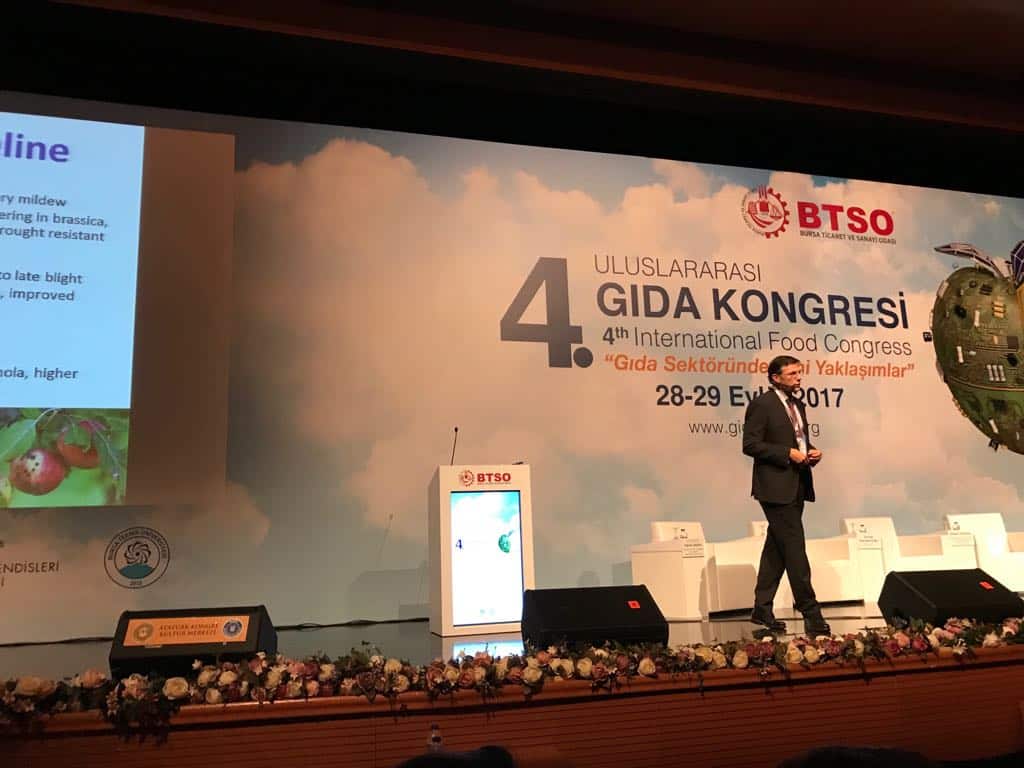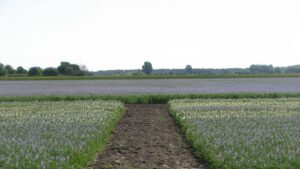European Seed editor a keynote speaker at Food Congress in Turkey
Each night, close to 800 million people go to bed hungry. Plant breeding and the seed sector can help reduce global hunger, but regulatory burdens and asynchronicity are often blocking progress. Strong and effective IP, regulatory alignment and an integrated approach should be considered when attempting to mitigate hunger.
There are many definitions of hunger. The Food and Agriculture Organization (FAO) defines hunger as the distress that is associated with lack of food. Such food deprivation is a food consumption that is insufficient enough to provide the dietary energy one needs to live a healthy and proactive life. Under-nutrition means there are deficiencies in energy, protein or the essential vitamins and minerals needed and is often the result of the inadequate intake of food and poor food quantity and quality. Malnutrition is the combination of both under-nutrition and over-nutrition – an unbalanced diet that involves consuming too many calories in relation to the energy requirements needed.
European Seed’s own Marcel Bruins was invited to speak as keynote speaker at the 4th Food Congress, held in Bursa, Turkey Sept. 28-29, 2017. In his presentation, Bruins looked at these definitions, the progress towards reducing global hunger and the role of plant breeding and the seed sector in this.
Just the Facts
When it comes to discussing hunger, one needs to find a way to measure it, preferably on an annual basis to assess progress. The International Food Policy Research Institute (IFPRI) issues annually the Global Hunger Index (GHI) in an attempt to quantify various parameters that make up hunger. The most recent GHI, from 2016, states that a majority of African nations and some southern Asian countries face serious to alarming hunger levels. The seven countries in the highest ‘Alarming category’ are Central African Republic, Chad, Zambia, Haiti, Madagascar, Yemen and Sierra Leone. In 1990, there were 17 countries in the ‘Extremely alarming’ category, a number that has gradually decreased and eventually entirely disappeared by 2015. Hunger has fallen in all continents since 1990 and 85 countries have cut hunger by at least 25 per cent. But hunger in 52 countries is still serious or alarming and the worst hunger is in Africa, south of the Sahara. The world-renowned medical journal The Lancet estimates that every 10 seconds a person dies of hunger or malnutrition. This adds up to well over 4000 people per day – a shocking number.
[tweetshare tweet=”Hunger has fallen in all continents since 1990-85 countries have cut hunger by 25%” username=”EuropeanSeed”]
“We are definitely making progress in decreasing hunger, but there’s still an estimated 800 million people that go to bed hungry each night. So, we need to do more. And that responsibility is on all of us” says Bruins.
The Future of Hunger
But how do we take the knowledge we have in hand, be proactive, and ensure that we can get these numbers down? How do we ensure we can live in a future world without hunger being an issue?
It is all about planning for future numbers.
In 2020, the world’s population should hit 7.75 billion people. In order to get things right, the World Water Council (WWC) estimates we need to ensure we have 17 per cent more water available to feed the world and the International Food Policy Research Institute (IFPRI) says we need the world agriculture’s GDP to decrease by 16 per cent due to global warming.
In 2025, the United Nations Environment Programme (UNEP) states that two thirds of the world’s population will be in water and drought stressed conditions, and the World Bank states that one ha will be needed to feed five people, whereas in 1960, the same area would feed two people.
Finally, in 2050, 50 per cent of current arable land will become unusable (UNCCD – United Nations Convention to Combat Desertification), the United Nations is estimating the worlds population will hit 9.7 billion, global food demand will increase 2.5 times (Business and Industry Advisory Committee, BIAC) and FAO states agricultural production will have to increase two to three times than the output we have now.
“There are many challenges facing the agriculture sector in terms of reducing/eliminating hunger and increasing the amount of food for the starving world,” adds Bruins. “For example, we’re seeing that a constantly larger part of the world population will be living in cities. By 2050 this will be more than two thirds of mankind. Also, the amount of arable land per inhabitant will have decreased from 0.43 ha in 1960 down to 0.15 ha in 2050.”
The Challenges for Agriculture
One such factor is that there is a consistent population and energy increase while the number of farms and farmers are decreasing. Access to water and nutrient rich soil is becoming more difficult, and therefore more efficient food production strategies are required. This in turn requires innovation, which is a crucial component in the fight to reduce global hunger. In terms of plant breeding, innovation translates into newly bred, improved and locally adapted varieties, perfecting and enhancing specific traits, and new breeding techniques that can be utilized in the countries facing the largest hurdles. The end result would not only be better performing plants, but would help in the increase in yields and profits.
The Contributions of Plant Breeding to World Hunger
Plant breeding is the art and science of changing the genetic make-up of plants in order to produce desired characteristics to the benefit for mankind, and nowhere else would this advancement be felt more than in hunger stricken countries. Plant breeders reassemble existing diversity, and create new diversity, all with the help of special techniques and technologies.
“I ask people to think back of the breakfast they had that morning, and then continue to point out that, with the exception of maybe fish, all of their breakfast and virtually all of their lunch and dinner started out as a seed” Bruins shared. “But I also point out that progress, for example, in yield has been very low until we finally started to understand more of the genetics behind plant breeding. For example, wheat yields in France from 1815 onwards were around one ton per hectare all the way until the 1950s. At that point plant breeders started to realize the impact of certain actions, and yield progress took off. The same in maize: very low yields of around 1,5 ton per hectare till the 1930s, after which yield quickly increased to 10 ton per hectare”.
Plant breeders have been changing various plant characteristics such as yield, resistance to pests and diseases, tolerance to abiotic stress, such as drought, taste, size, quality and many more. And by changing these characteristics, they have increased food security, and alleviated hunger. By adding resistances to plant varieties, there was a lower need for crop protection products to be used and at the same time decreasing drastically the amount of fossil fuel that is needed to disperse the products over the field. Also, the increase in yield has tremendously decreased deforestation, leading to a conservation of biodiversity. But it is easy to imagine that such advancements need investments, which are high, upfront and long-term. And in order to stimulate the creative minds on this planet, mankind has invented the concept of intellectual property (IP), to guarantee a certain return on the (research) investment.
“At this point I usually show on screen the golden circle of innovation, starting with R&D leading to Innovation, which is then protected by intellectual property which guarantees return on investment and this ROI can then be re-invested in R&D,” Bruins states.
Intellectual Property
Strong and effective IP is a prerequisite to encourage further research efforts and can be considered as the ‘engine of innovation’. But let’s not forget that the return on investment is only a small portion of the benefits. Studies have shown that the farmers are reaping 75 per cent of the total benefits of plant breeding. An Iowa State University study found that farmers are getting $6 benefit for each $1 spent on private sector research. According to another report by the British Society of Plant Breeders, £1invested in plant breeding means £40 in added value across the wider economy, taking into account higher yields and input savings at the farm level as well as export earnings and enhanced processing efficient within the food and drink manufacturing sector. More specifically to the EU, an HFFA report was issued in 2016 by author Noleppa, investigating the economic, social and environmental value of plant breeding in the European Union. The study found that in the agricultural sector alone, genetic crop improvements had generated an additional social welfare gain of 9 billion€ and that it had added over 14 billion€ to the EU GDP. Plant breeding had secured more employment and had lead to an increase of income: on average a 7000 € increase, which is about 30 per cent of the annual income of an EU arable farmer, all induced by plant breeding. And thanks to plant breeding, 70.000 jobs has been created in arable sector.
[tweetshare tweet=”Strong and effective Intellectual Property is the engine of innovation.” username=”EuropeanSeed”]
Plant breeder’s toolbox
Plant breeders have many technologies in their toolbox, from cross-, selection- and mutation-breeding, to tissue culture, genetic engineering and since lately precision breeding. Since the 1980s, several new tools have been added to the plant breeder’s toolbox, which are often grouped together under the more general term plant breeding innovation, or sometimes referred to as new plant breeding techniques. Although the earliest of these tools have been developed and first applied to plant breeding programs in the 1990ies, the more recent ones are from the last decade, with the Crispr-Cas technology leading the pack. Other methods that have been added to the toolbox are reverse breeding, synthetic genomics, cisgenesis and intragenesis, grafting, RNA-dependent DNA methylation, oligonucleotide directed mutagenesis, agro-infiltration, and gene or genome editing.
These tools generate similar outcomes to those that can be achieved through traditional approaches, albeit more precisely and efficiently, faster and not necessarily involving the introduction of foreign DNA. And because these new methods are more efficient and economical when compared to traditional approaches, they are more accessible to public and commercial plant breeders in developed and developing countries and can be used across all agriculturally important crops, including field, vegetable and specialty crops.
In the plant breeding innovation pipeline, there are a few things in the works that look promising:
- Gene Editing: Powdery mildew resistant wheat, longer shelf-life tomatoes, changed pod-shattering in brassica, altered grain dormancy in barley, non-brewing mushrooms, and drought resistant corn.
- Cisgenics/Intragenics: Apple scab resistance, potato late blight resistance, drought/cold tolerant maize, fungal resistant papaya, improved forage ryegrass, and a variety of vegetable crops.
- Grafting: Citrus trees with transgenic rootstock.
- ZFN (-1/-2/-3): Improved nutritional quality maize and canola, higher yield tomatoes, disease resistance wheat, and nematode resistance.
- ODM: Herbicide tolerant oilseed rape and flax.
Although the above sounds promising, countries around the world are struggling with the question whether they should regulate the products of this plant breeding innovation in a similar manner as transgenics or not. In general, two questions arise, especially in those countries where GMOs are regulated under specific legislation:
1) Do the current regulations in those countries encompass the use of these new methods or not?
2) Should the plant varieties that have been developed by these new methods be regulated in a similar way as GMOs or not?
While initial decisions have already been taken in a limited number of countries relating to one or more of these new methods, discussions have only just started in others. So how do you move ahead with this when so many countries have differing legislations?
Principles and criteria
To help governments take a decision on how to regulate or not regulate the products of plant breeding innovation, the seed sector has spent several years discussing this and came up with the underlying principle that plant varieties developed through the latest breeding methods should NOT be subject to additional regulations if they could have been produced through earlier breeding methods, or might also have been obtained from natural processes without human intervention.
To further specify this, the sector developed criteria to be used by governments. The resulting product would NOT fall under the current scope of GMO regulation if:
- it does not contain a novel combination of genetic material; or
- the final plant product solely contains the stable insertion of inherited genetic material from sexually compatible plant species; or
- any form of mutagenesis is involved.
Integrated approach
But the seed sector cannot do this alone, and any approach towards reducing global hunger has to be fully integrated. The chain is only as strong as the weakest link. Therefore, we will need innovative solutions for shortage of water, smart fertilizers & crop protection, green light for R&D, safeguarding natural resources, smarter animal feed and more. One of the main pillars is that the regulations on certain topics need to align with each other across the globe. We have seen too often that regulatory divergence has lead to severe trade disruptions, and through that, endangering food security. Also, no country alone can solve this problem; this has to be a global effort.
There are massive global challenges ahead with regards to ensuring food security and reducing global hunger. Countries would make a good start by further stimulating the plant breeding and the seed sector at a local and at global level, keeping in mind not to block innovation and ensuring an aligned regulatory approach. Reducing hunger is certainly not Utopia.













